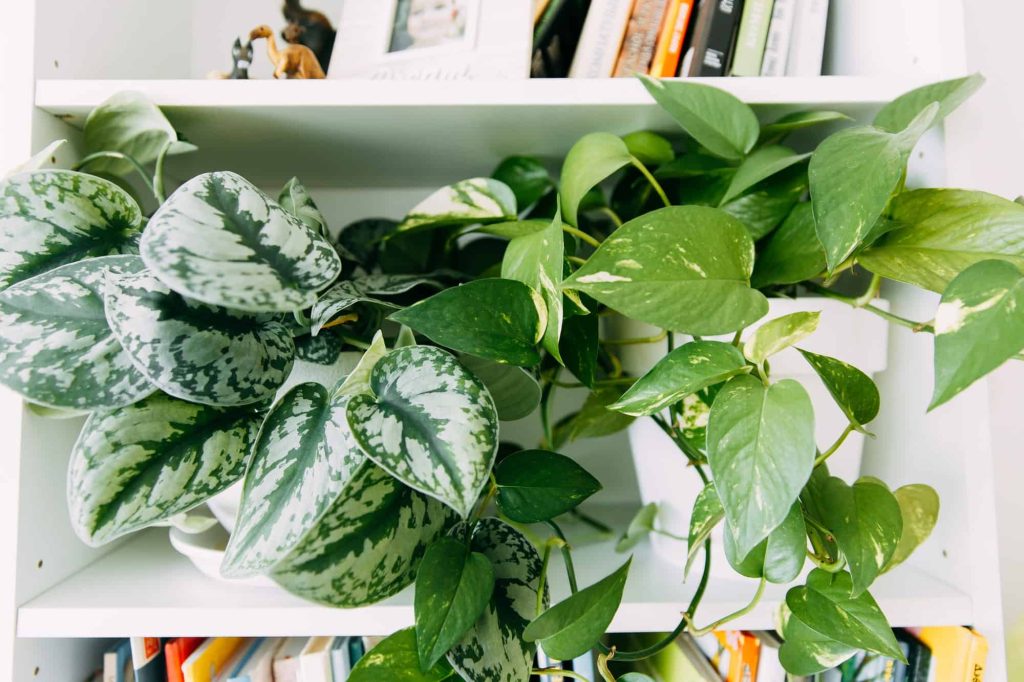We believe that it is impossible to find and exhaust all the plants in the world, this is because right when you find yourself drooling over one, another is trending already. The good thing about the recent houseplants on the trend is that many of them are easy to grow.
One of the recent plants on the must-have list of every gardener is the sterling silver plant. The sterling silver plant is characterized by its thick, dark green foliage, with a silver sheen on it. We love the sterling plant because of how easy it is to grow and care for; however, the sterling silver plant is a slow-growing plant.
We know you cannot wait to grow the sterling silver plant, however, unfortunately, the sterling silver plant is not an easy one to find, they can only be found in a few nurseries or online. Are you looking to grow the sterling silver plant? We thought to make things easy for you and to provide the best care guide you can find.
Sterling Scindapsus Plant Explained
| Common name | Sterling silver Scindapsus |
| Botanical name | Scindapsus treubii |
| Plant type | Tropical aroid |
| Soil type | Moist, well-draining |
| Soil Ph | Not specified |
| Water | Evenly watered |
| Temperature | 65 degrees F to 75 degrees F |
| Light | Bright, indirect light |
| Native | Southeast Asia |
| Toxicity | Toxic. |
The sterling silver Scindapsus plant, also known by its scientific name Scindapsus treubii is a relative of both pothos and philodendron, however, it isn’t as common as both genus’. The sterling silver Scindapsus originates from the rainforest and tropical jungles of Southeast Asia; they are also native to pacific islands and Queensland.
The sterling plant can grow to about 4 inches in height.
Sterling Silver Scindapsus Varieties
In the Scindapsus genus, there are different cultivars that you can grow from, while some are variegated, some are not. The good thing about having different types is that you can grow as many plants from a single genus as you would want to. Like the Scindapsus treubii, we regret to tell you that many types are difficult to find.
1. Scindapsus Pictus “Silver Lady”
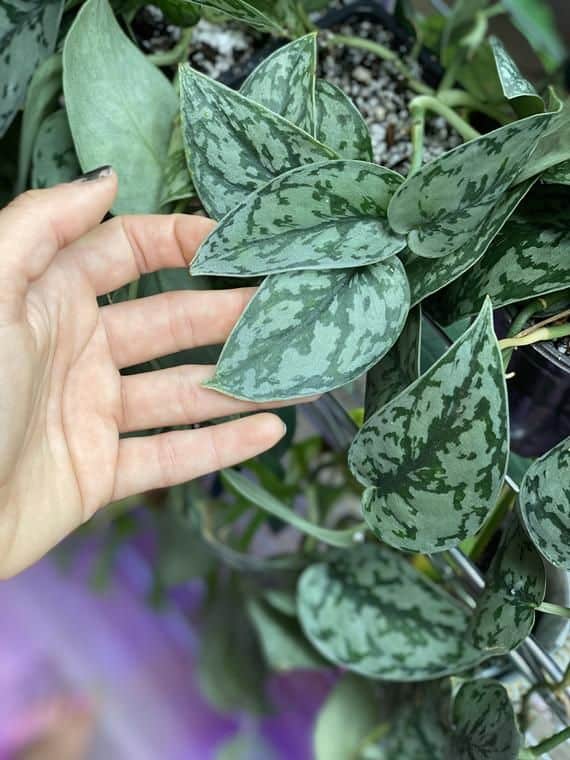
The Scindapsus pictus silver lady is just as stunning, as its other relatives. The plant has variegated leaves that stand out and resembles the reversed pattern of Scindapsus pictus argyraeus, its relative. The plant has large leaves and is characterized by its distinct patterns.
2. Scindapsus Hederaceus
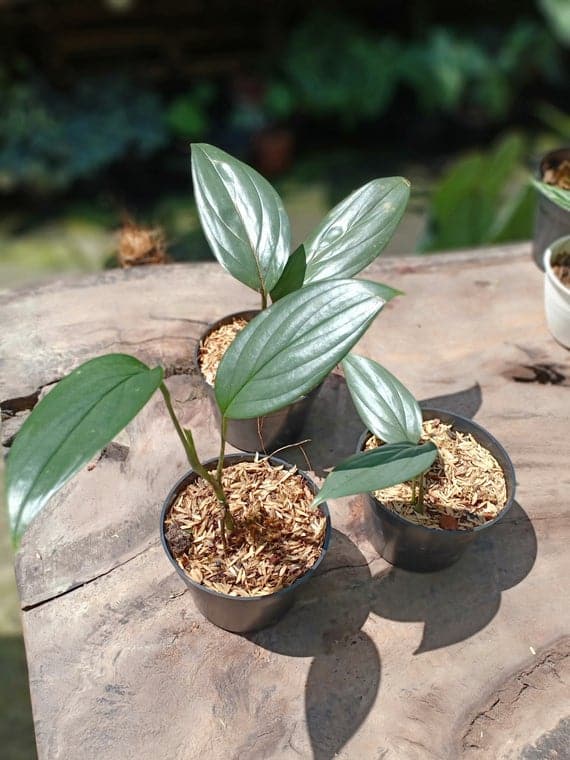
The hederaceus variety can be likened to another variety of the Scindapsus, the Scindapsus officinalis, a medicinal plant that cannot be grown indoor. The hederaceus variety is characterized by its shiny, green leaves, the plant is native to Thailand, Indo-China. It was mostly found in climbing trees and rocks, in its natural habitat.
3. Scindapsus Pictus
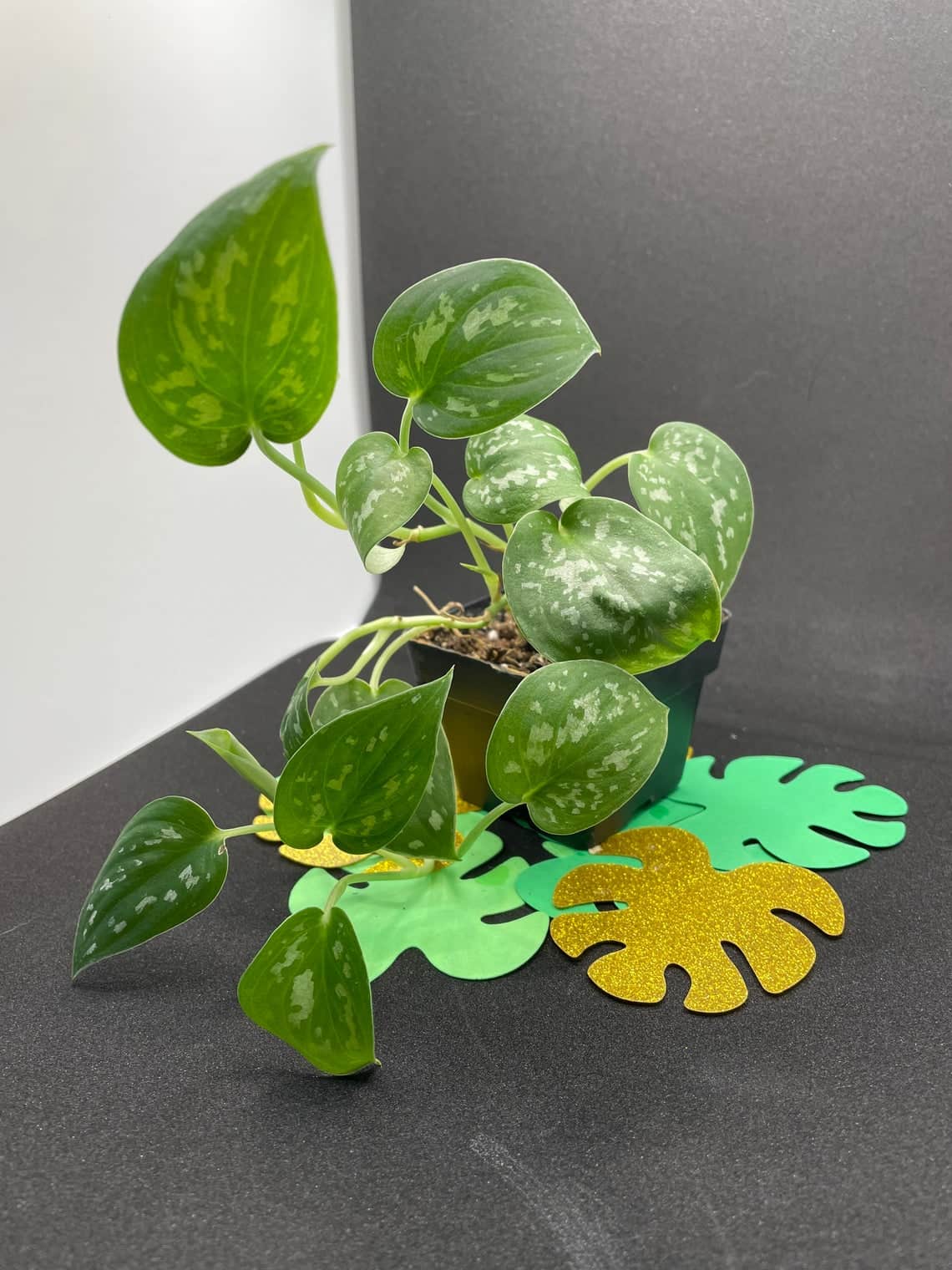
Of all the types of Scindapsus, the Scindapsus pictus is the most common one grown as a houseplant. Compared to others, it is also easily found in nurseries and online. The plant earned its name from the beautiful silver patches on the plant’s green leaves.
The pictus also has its varieties, commonly characterized and known for their variegated leaves. they are Scindapsus pictus Argyraeus, Scindapsus pictus exotica, Scindapsus pictus silver satin, Scindapsus pictus silvery ann. These plants have beautiful foliage and if you do find them around, you should care for them properly so they live longer.
4. Scindapsus Pictus Silver Hero Or Platinum
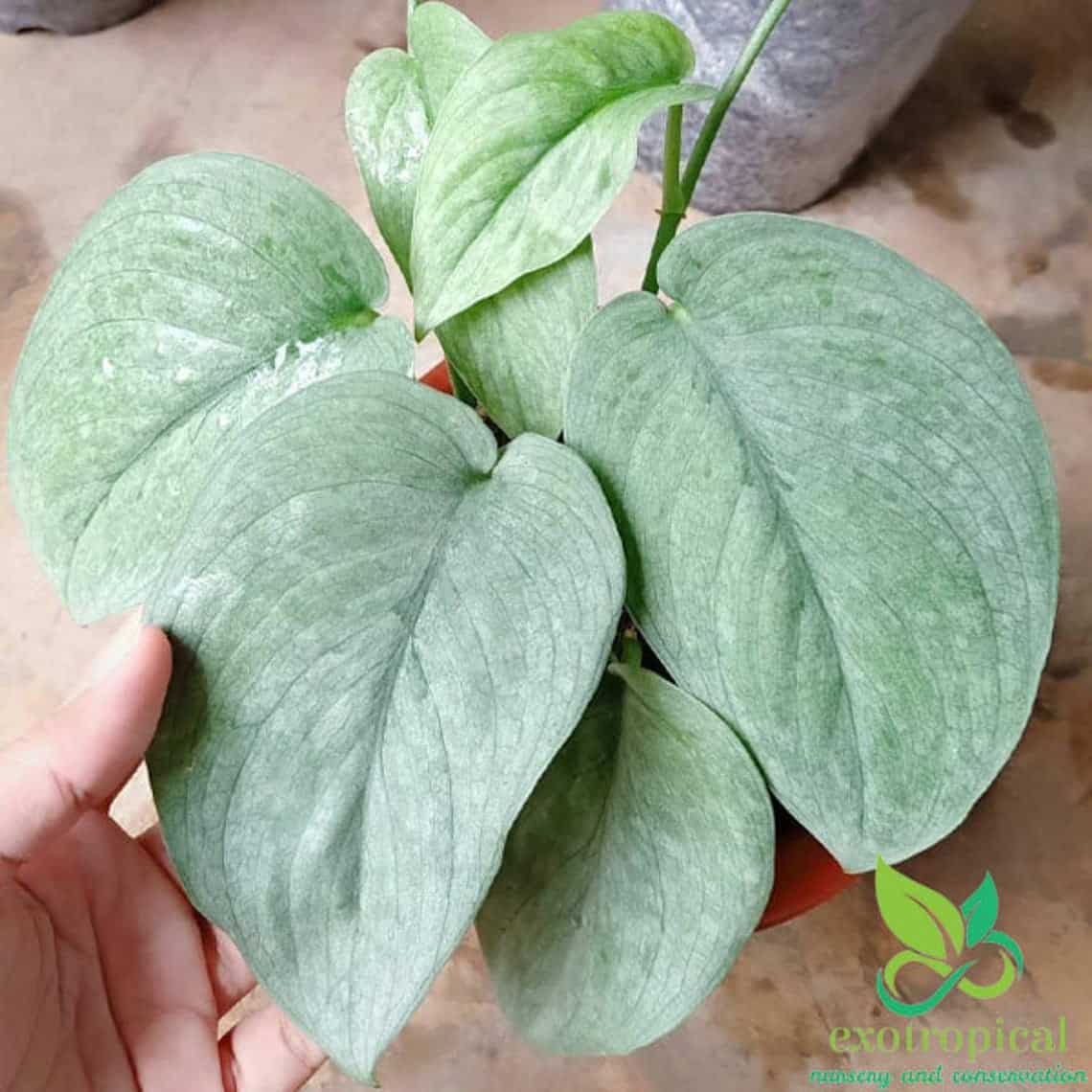
The silver her or platinum variety is a beautiful and distinct type of Scindapsus, the plant was discovered in a private garden and silver-grey leaves stood out, the plant is known to shimmer when it is tilted towards the light.
Sterling Scindapsus Plant Propagation
Who wouldn’t want to have more of the sterling plant in their home? Propagating the sterling silver plant allows you to have the plant around you for the longest of time, especially since it’s a rare one to find, you can also gift your friends or relatives or even better? Sell it! Because of the plant’s nature of growing slowly, we do not recommend propagating them in water. Propagation should be done at the beginning of the growing season. Follow the steps below to propagate your plant properly.
Sterling Scindapsus Plant Propagation via Stem Cutting
- Identify and select a healthy plant, select a stem that has at least one node and make your cutting beneath this node. Make sure your cutting is about 3 to 4 inches long.
- Get rid of the bottom leaves and leave at least two leaves on top. Place the end of the cutting in rooting hormone, this is to speed up the rooting process for your plant.
- Prepare a potting mix in a container; you should add perlite to enable proper drainage and dip your plant into the soil. Keep the soil moist.
Sterling Silver Scindapsus Plant Care
Apart from being a beautiful plant that fits perfectly in any space, the sterling plant is known and loved for its low maintenance. If you are a beginner, we recommend that the sterling plant be part of the first plants you grow. It’s that easy!
1. Light
Providing light for the sterling silver plant will not stress you. Surprisingly, the sterling plant will survive in low light to bright indirect light.
However, it will not grow as full or lush as it should be. Exposure to direct sunlight will scorch and damage the leaves of the plant. Sterling can be placed in a location where it will receive bright, indirect light. The sterling silver Scindapsus can also grow with artificial light.
2. Soil
The plant only prefers well-drained and slightly acidic soil. You can also add a mix of perlite to your soil to aid proper drainage. The sterling silver plant will grow properly when it is provided the right type of soil. We also recommend that you purchase a pot or container that has at least 2 drainage holes, this will also aid in proper drainage for your plant.
3. Water
Asides from the sterling silver plant, water is really important to all plant care, unfortunately, a lot of people make mistakes with this aspect. Water your plant thoroughly and then let it drain; use the finger test to check when your plant is ready to be watered again.
Your soil is ready for more water when the top 2 inches are dry. Your sterling silver plant does not enjoy being overwatered; however, it loves to be kept moist. It is safe to say your plant wants balance. You can also make use of a soil sleuth to properly gauge the moisture level of your soil and if it is ready to be watered again.
4. Humidity
The sterling silver Scindapsus’ ideal humidity should be around 60%, which means that your sterling plant has a high humidity requirement.
However, the plant can survive as low as 40%. We advise that you grow the plant in places with high humidity in your home i.e., the bathroom or kitchen. You can also look for ways to provide humidity for your plant. I.e., mist your plant regularly, place your plant on a peddle tray or you can purchase a plant humidifier for your plant.
5. Temperature
The sterling silver Scindapsus will grow best in the temperature range of 65 degrees F to 75 degrees F, preferably, any temperature above 55 degrees F is perfect for your plant. If you grow your sterling silver plant outdoors in the spring and summer, we advise that you take it in when the temperature falls below 53 degrees F.
Your plant will also tolerate being placed in cooler temperatures; however, it should be protected from freezing temperatures.
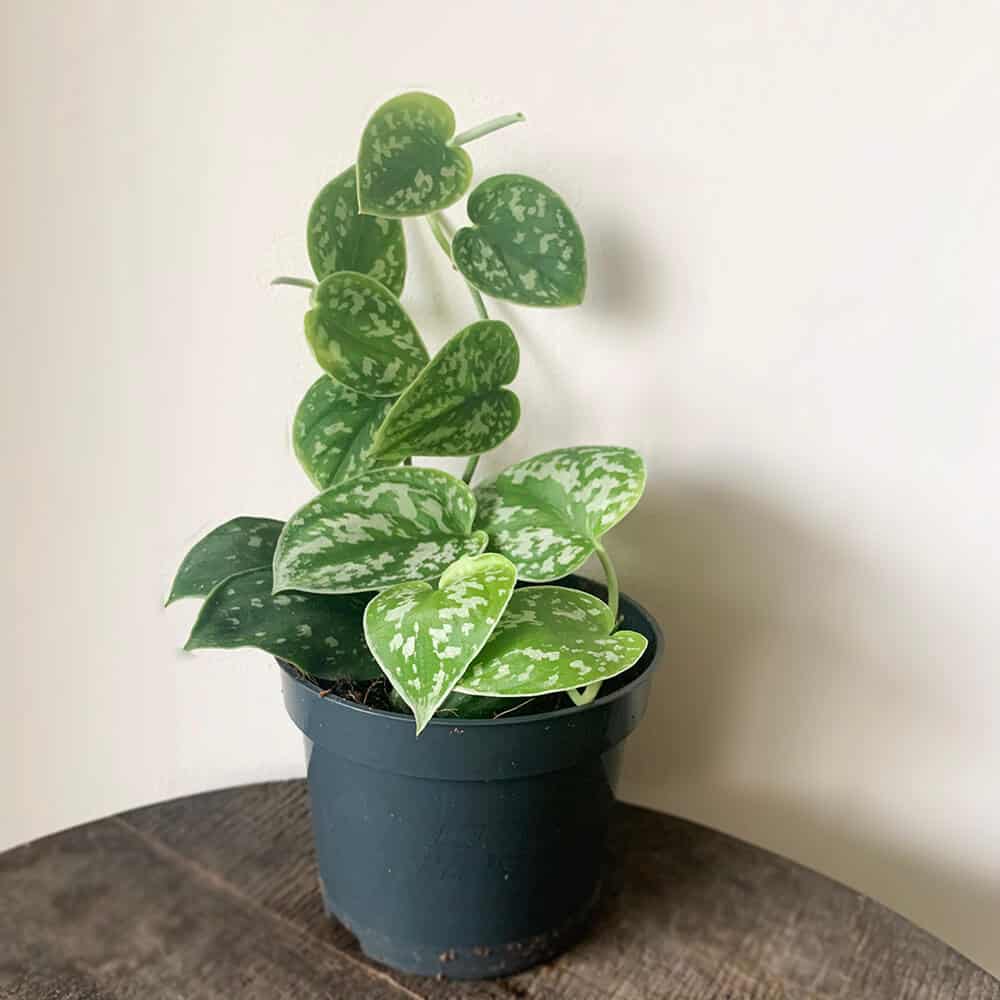
6. Fertilizer
The sterling silver plant will not mind being fertilized, once or twice a year. Provide your plant with fertilizer that is has a slightly high nitrogen content. This can be done both at the beginning of the growing season and the end. We recommend that you make use of liquid fertilizer and that you dilute it to half its strength before applying it to the plant. Fertilizing should be stopped during fall and winter as your plant has entered its dormancy phase.
Sterling Silver Scindapsus FAQs
Can My Sterling Plant Survive In Low Light?
Yes, although the sterling plant prefers and thrives well in bright, indirect light, it will live and grow in low light too. Your plant will also do well with artificial lighting, little wonder it is one of the most popular houseplants for offices.
Can A Sterling Silver Scindapsus Plant Be Grown Outside?
Yes, the sterling silver plant will grow well outdoor. You only have to watch for when the temperature drops and bring them in during this time. This will help them live longer.
Why Does My Sterling Plant Have Yellow Leaves?
If your plant is turning yellow when it is old, that is fine. However, the most common cause of yellow leaves in young plants is a result of soil moisture. It is either your soil is too dry or too wet. We recommend that you observe your plant to determine the problem and adjust. Prevention is better than cure; we also advise that you balance your watering routine to prevent your plant’s leaves from turning yellow. Always remember to perform the finger test for effective watering.
Why Is My Sterling Plant Curling?
Under-watering is the number one cause of curly leaves. You have probably left your plant to be alone for too long. To fix this, we recommend that you water the plant thoroughly; your plant will feel heavier when it is properly watered. You can also dip your plant into warm water and allow the plant to soak in some water.
Can I Buy Scindapsus Online?
Yes, the Scindapsus treubii is a rare plant, this means you may not find them in local nurseries or plant shops around you. The next sure place we recommend online. We also need to inform you that depending on where your plant is coming from, it can be expensive.
Is The sterling Silver Scindapsus Toxic?
Yes! you might want to keep your pets and children away from your plant as this plant can be harmful to them. contact your medical or veterinary doctor, if you notice your pets or children have gone close to the plant.
Final Thoughts
We understand the worry that comes with not finding it close by. Below are few things we want you to keep in mind, to properly care for your Scindapsus treubii
- Your sterling plant can be susceptible to common houseplant pests such as scale, mealy bugs, or spider mites. We advise that you treat this with neem oil or an insecticide.
- Most issues with the aglaonema plant such as the sterling arise from soil/water. It is important that you pay attention to your watering schedule and also make sure your soil is well-draining.
- The sterling silver plant does not require being moved to another pot. However, if you will love to place your pot in fresh soil, you can wait until your plant starts poking out of its drainage holes, then you can re-pot. Ensure your plant is moved to a pot that is bigger than the former size.
- With the Scindapsus treubii, pruning may not be necessary. However, you can shed off the old and damaged leaves to keep the plant healthy and fuller.
The sterling silver Scindapsus is one of the easiest plants and pleasant houseplants you can grow provided you follow the best care guide.
How to care for similar plants:

